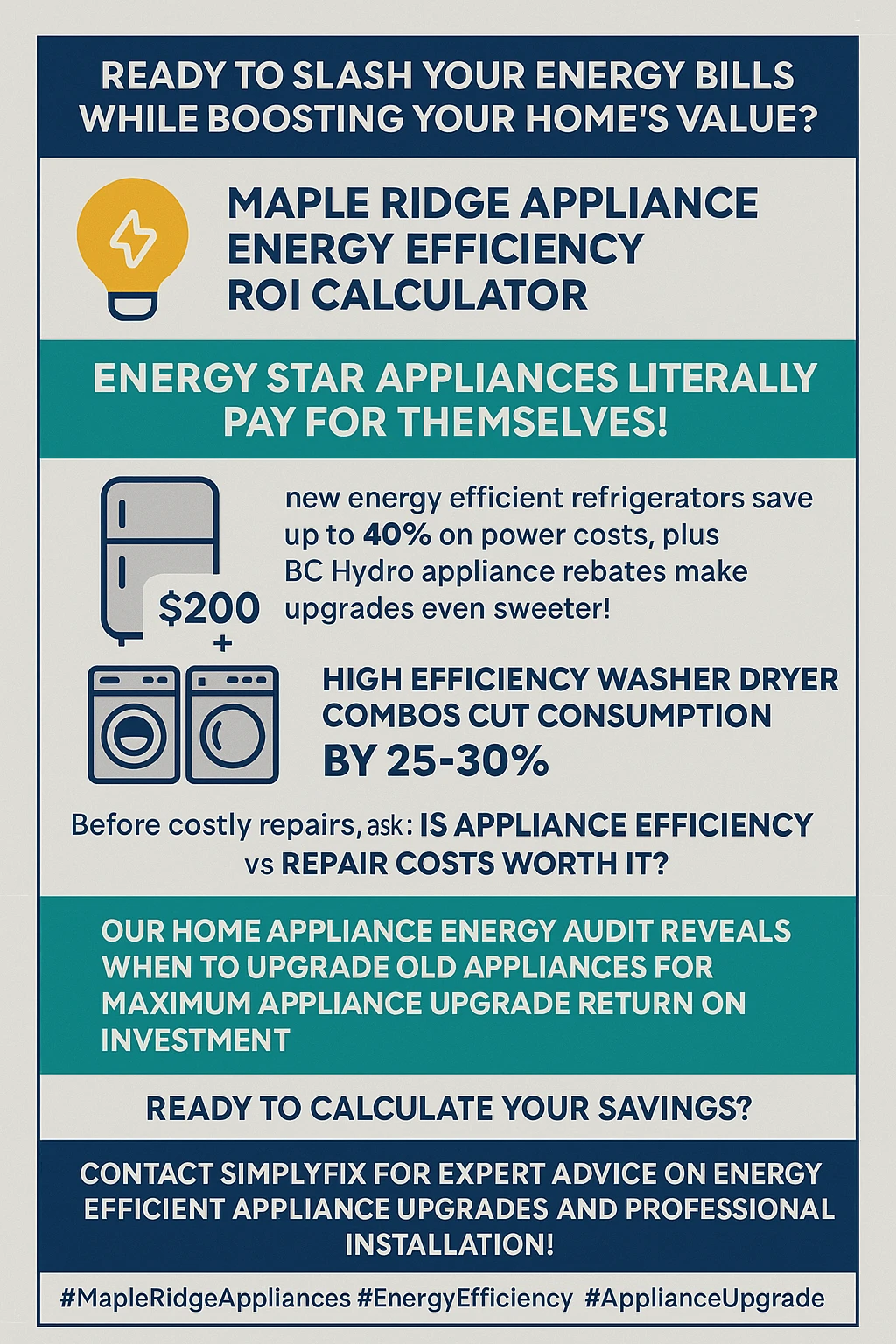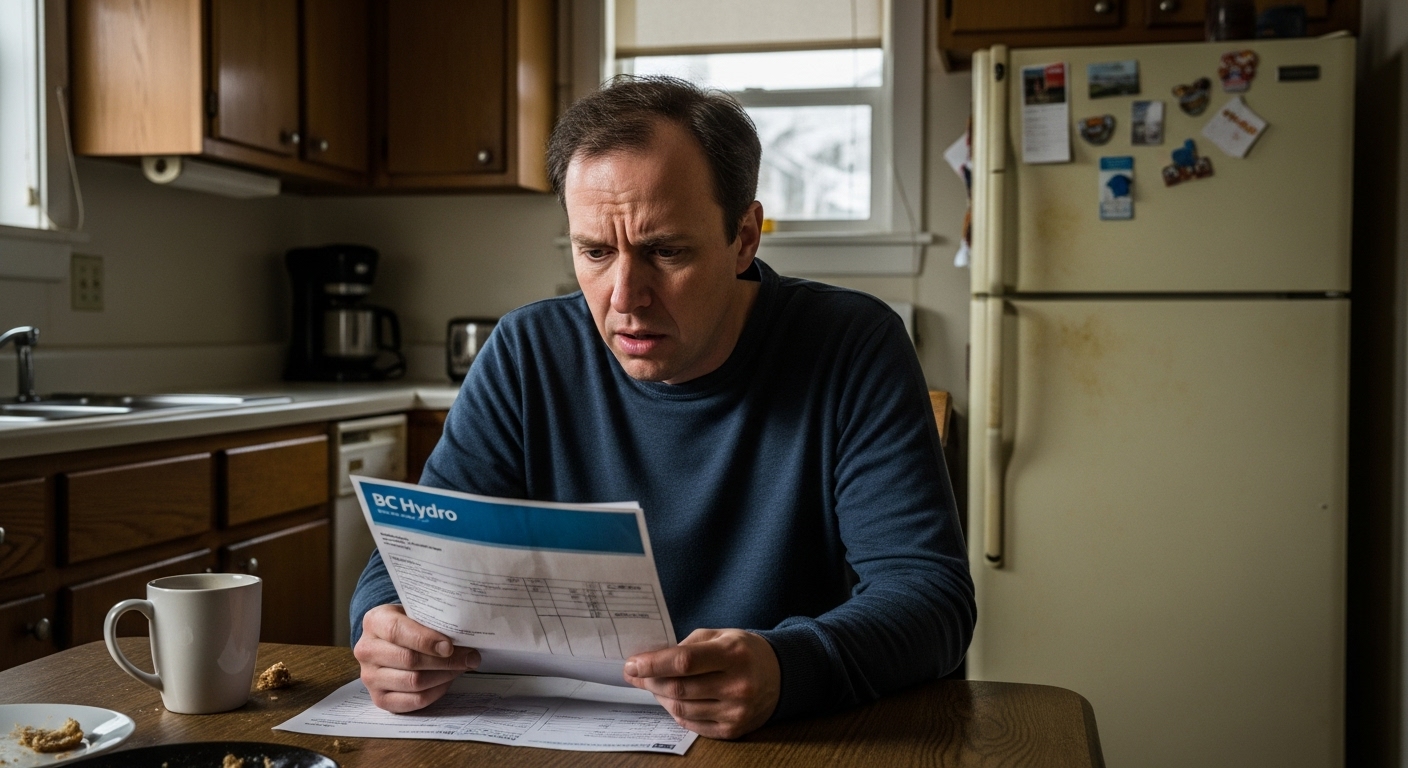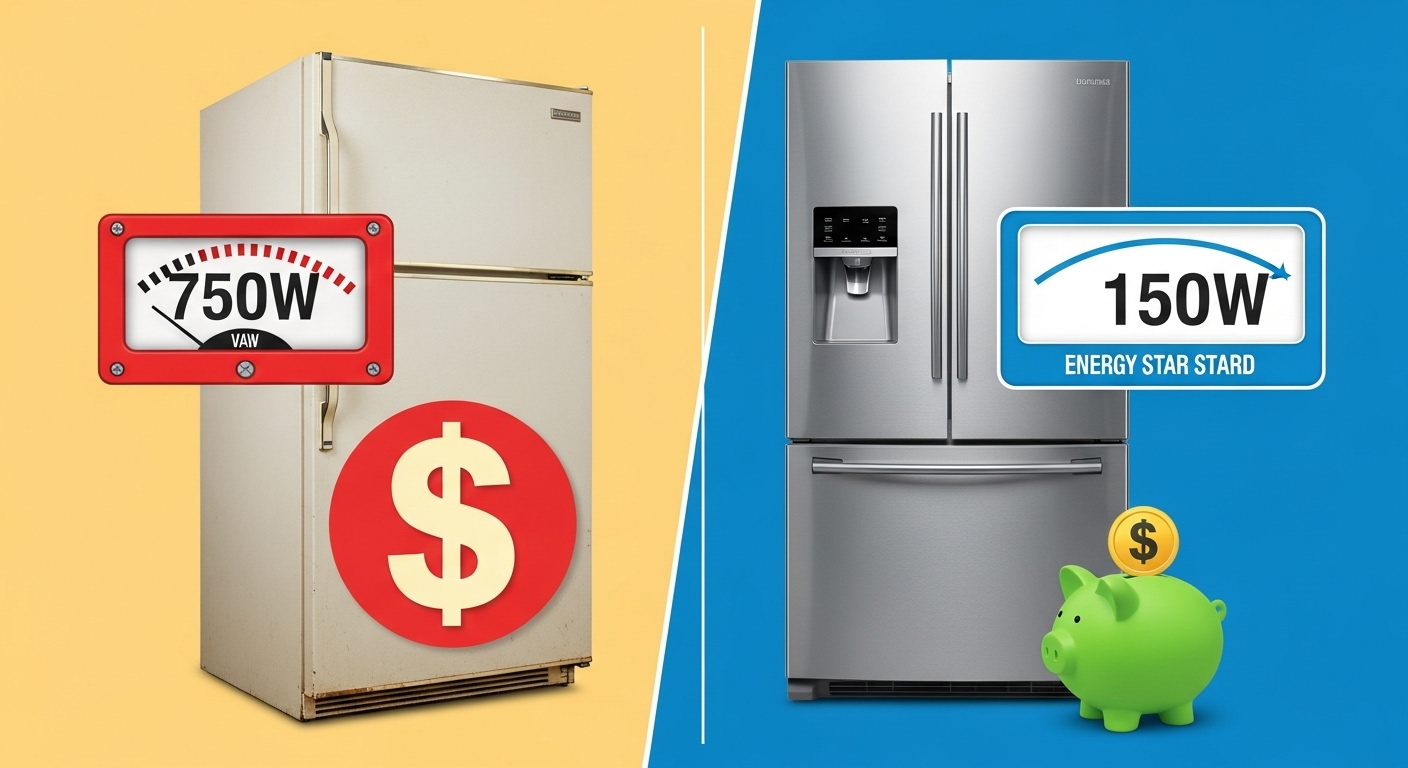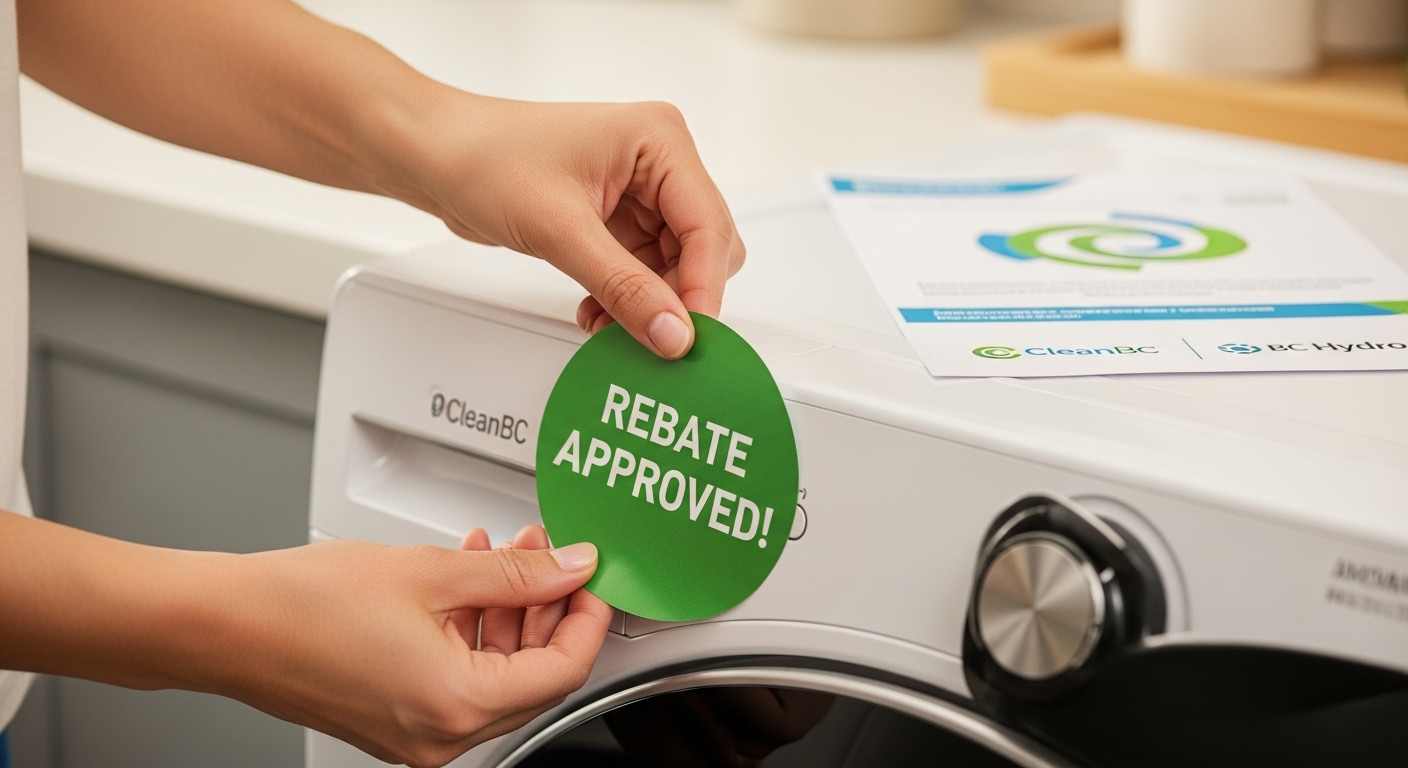Appliance Energy Efficiency Upgrades That Actually Pay for Themselves: A Maple Ridge Homeowner’s ROI Calculator
Ready to slash your energy bills while upgrading your home’s appliances? We’ll walk you through the exact calculations and rebate opportunities that make energy-efficient appliances a smart financial investment for Maple Ridge homeowners, plus show you which upgrades deliver the biggest bang for your buck.
Picture this: you’re staring at your monthly BC Hydro bill, wondering how on earth your energy costs keep creeping higher despite your best efforts to conserve. Your trusty old fridge hums loudly in the corner, your washing machine sounds like it’s launching into orbit, and your ancient dryer takes forever to get clothes actually dry. Sound familiar? If you’re like most Maple Ridge homeowners, you’ve probably wondered whether those shiny new Energy Star appliances are actually worth the investment, or if they’re just marketing hype designed to separate you from your hard-earned cash.
Here’s the thing that might surprise you: when you crunch the numbers properly, many energy-efficient appliance upgrades don’t just pay for themselves over time – they actually become profit centers for your household budget. Between the dramatic improvements in appliance technology over the past decade, generous rebate programs from BC Hydro and FortisBC, and the steady rise in energy costs, the financial case for upgrading has never been stronger. The trick is knowing which upgrades to prioritize, how to time your purchases to maximize available rebates, and how to calculate the true return on investment that includes more than just energy savings. The reality is that strategic appliance upgrades can deliver returns that would make your investment advisor jealous. We’re talking about ROI percentages that often range from 20% to 95%, depending on what you’re replacing and how you structure the upgrade. But here’s where most homeowners get tripped up – they focus solely on the sticker price difference between basic and efficient models, completely ignoring the bigger financial picture that includes rebates, long-term savings, and even potential home value increases.
Key Outtakes:
- Energy-efficient appliances typically save Maple Ridge homeowners 20-50% on energy costs, with some upgrades like refrigerator replacements delivering $100-160 in annual savings alone
- BC residents can access up to $14,000 in combined rebates through CleanBC Better Homes and utility programs, dramatically improving payback periods for strategic upgrades
- The most financially rewarding upgrades include replacing refrigerators older than 10 years, upgrading to high-efficiency laundry systems, and installing heat pump water heaters
- Proper timing that aligns with natural appliance replacement cycles and available rebate programs can achieve positive ROI within 2-7 years for most major appliance categories
- Professional energy audits reveal which appliances consume disproportionate energy, enabling homeowners to prioritize upgrades based on maximum impact rather than age alone

Understanding the True Cost of Energy Inefficiency
Let’s start by talking about something that might make you wince a little – just how much your current appliances are costing you every single month. Most Maple Ridge homeowners severely underestimate the financial drain of keeping older, inefficient appliances running. We’re not just talking about the obvious energy consumption here; we’re talking about a multi-layered cost structure that includes higher energy bills, increased maintenance expenses, reduced performance, and the opportunity cost of missing out on available rebate programs.
Take refrigerators, for example, which are often the biggest energy hogs in your home because they never get a break. If your fridge is more than 10 years old, it’s probably consuming somewhere between 400-800 watts of electricity, compared to modern Energy Star units that sip just 100-180 watts. That difference translates to real money – we’re talking about $20 monthly to operate an older refrigerator versus less than $5 for a new efficient model. Over just one year, that’s a $180 difference, and over the typical 15-year lifespan of a refrigerator, you’re looking at $2,700 in excess energy costs alone. But here’s where it gets really interesting – and where the math starts working strongly in favor of upgrades. Those excess energy costs don’t exist in a vacuum. While you’re hemorrhaging money on electricity bills, appliance technology has been advancing at breakneck speed. Modern Energy Star appliances don’t just use less energy; they often perform better, last longer, and require less maintenance than their older counterparts. Your ancient washing machine that takes 45 minutes to complete a cycle and still leaves clothes slightly damp? A high-efficiency replacement not only uses 25% less energy and 33% less water, but it also extracts more moisture during the spin cycle, meaning your dryer doesn’t have to work as hard either.
The ripple effects continue when you consider that inefficient appliances often stress your home’s electrical system and can impact the performance of other equipment. An overworked air conditioner trying to compensate for heat generated by inefficient appliances, a water heater working overtime because your dishwasher can’t properly heat water, or circuit breakers tripping because older appliances draw more current – these seemingly minor issues compound over time into significant costs and headaches that efficient appliances simply eliminate.

Decoding BC’s Rebate Landscape for Maximum Savings
Now that we’ve established the financial pain of inefficiency, let’s dive into the good news – British Columbia offers some of the most generous appliance rebate programs in Canada, and understanding how to navigate these programs can literally save you thousands of dollars. The key is knowing which programs stack together, how to time your purchases for maximum benefit, and which specific models qualify for the biggest rebates. The CleanBC Better Homes and Home Renovation Rebate Program represents the granddaddy of all efficiency incentives, offering up to $14,000 in rebates for comprehensive home energy upgrades. While this program encompasses much more than just appliances, strategic appliance upgrades can form the foundation of a larger efficiency renovation that maximizes your total rebate potential. The program specifically targets upgrades that reduce greenhouse gas emissions, making electric heat pump water heaters, induction cooktops, and high-efficiency heat pump systems prime candidates for substantial rebates.
BC Hydro’s residential rebate programs take a more focused approach, offering specific dollar amounts for individual appliance categories. Current programs provide rebates ranging from $25 to $100 on qualifying refrigerators, clothes dryers, and clothes washers, with additional $50 rebates available for Energy Star-branded clothes washers in select municipalities. What many homeowners miss is that these rebates often run in cycles, with promotional periods offering instant point-of-sale discounts that can double or triple the standard rebate amounts.
FortisBC customers enjoy additional opportunities, particularly for natural gas appliances and dual-fuel systems. The utility offers rebates up to $250 on Energy Star certified washers and dryers, with higher rebates available for the most efficient models. Here’s where strategic planning pays off – homeowners in areas served by both BC Hydro and FortisBC can sometimes choose which utility programs to utilize based on which offers better rebates for their specific upgrade plans. Understanding your baseline energy consumption helps determine which rebate structure provides maximum benefit for your usage patterns.
The timing element cannot be overstated when it comes to maximizing rebate value. Many programs operate on fiscal year cycles, with the largest rebate pools available early in the program year and potentially reduced availability toward year-end. Additionally, manufacturer rebate programs often complement utility incentives, creating windows where stacked savings can reduce your net appliance cost by 30-50% or more. Smart homeowners track these cycles and plan major appliance purchases during peak rebate availability periods.
But here’s a pro tip that most people overlook – some rebate programs require pre-approval or specific documentation that must be submitted before purchase. Missing these requirements can cost you hundreds or even thousands in lost rebates. The key is to research rebate requirements first, then shop for qualifying models, rather than falling in love with a specific appliance and hoping rebates will be available.

The High-Impact Upgrade Priority Matrix
Not all appliance upgrades deliver equal returns, and understanding which upgrades to prioritize can mean the difference between a smart investment and an expensive mistake. The secret lies in focusing on appliances that combine high energy consumption, significant efficiency improvements in newer models, generous rebate availability, and natural replacement timing. Let’s break down the hierarchy of high-impact upgrades that deliver the biggest financial returns for Maple Ridge homeowners.
Refrigerators top the priority list for most households because they operate 24/7 and the efficiency gap between older and newer models is enormous. If your refrigerator is more than 10 years old,


Recent Comments